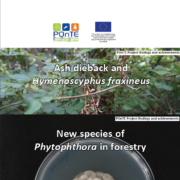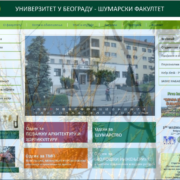Isolation and pathogenicity of Phytophthora species from poplar plantations in Serbia
Authors
Ivan Milenković (1, 2)*, Nenad Keča (2), Dragan Karadžić (2), Zlatan Radulović (3), Justyna A. Nowakowska (4), Tomasz Oszako (5), Katarzyna Sikora (6), Tamara Corcobado (1) and Thomas Jung (1, 7)
Affiliations
(1) Phytophthora Research Centre, Mendel University in Brno, Zemědělská 1, 61300 Brno, Czech Republic
(2) Faculty of Forestry, University of Belgrade, Kneza Višeslava 1, 11030 Belgrade, Serbia
(3) Institute of Forestry, Belgrade, Kneza Višeslava 3, 11030 Belgrade, Serbia
(4) Faculty of Biology and Environmental Sciences, Cardinal Stefan Wyszynski University in Warsaw, Wóycickiego 1/3 Street, 01-938 Warsaw, Poland
(5) Faculty of Forestry, Białystok University of Technology, Marszałka J. Piłsudskiego 1A, 17-200 Hajnówka, Poland
(6) Forest Research Institute-IBL, Braci Leśnej 3, 05-090 Raszyn, Poland
(7) Phytophthora Research and Consultancy, Am Rain 9, 83131 Nussdorf, Germany
Abstract
During a survey in three declining and three healthy poplar plantations in Serbia, six different Phytophthoraspecies were obtained. Phytophthora plurivora was the most common, followed by P. pini, P. polonica, P. lacustris, P. cactorum, and P. gonapodyides. Pathogenicity of all isolated species to four-month and one-year-old cuttings of Populus hybrid clones I-214 and Pánnonia, respectively, was tested using both a soil infestation and stem inoculation test. Isolates of P. polonica, P. × cambivora, P. cryptogea, and P. × serendipita from other host plants were included as a comparison. In the soil infestation test, the most aggressive species to clone I-214 were P. plurivora, P. × serendipita, and P. pini. On clone Pánnonia, P. gonapodyides and P. pini were the most aggressive, both causing 100% mortality, followed by P. cactorum, P. × cambivora, and P. polonica. In the underbark inoculation test, the susceptibility of both poplar clones to the different Phytophthora species was largely similar, as in the soil infestation test, with the exception of P. polonica, which proved to be only weakly pathogenic to poplar bark. The most aggressive species to clone I-214 was P. pini, while on clone Pánnonia, the longest lesions and highest disease incidence were caused by P. gonapodyides. Phytophthora cactorumand P. plurivora were pathogenic to both clones, whereas P. × cambivora showed only weak pathogenicity. The implications of these findings and possible pathways of dispersion of the pathogens are discussed.
This research was funded by: Ministry of Education, Science and Technological Development, Republic of Serbia, grant number TR 37008; European Union’s Horizon 2020 research and innovation programme under grant agreement—“Pest Organisms Threatening Europe-POnTE” Project ID: 635646; “Phytophthora Research Centre”, funded by the Czech Ministry for Education, Youth and Sports and the European Regional Development Fund, grant number CZ.02.1.01/0.0/0.0/15_003/0000453.
Published on June 6, 2018 by FORESTS









